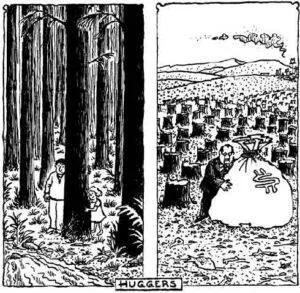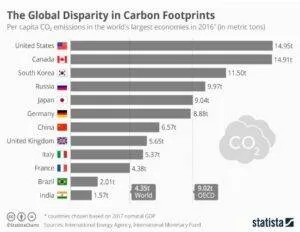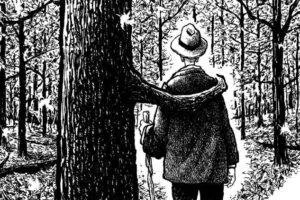Hey Canada: How about we stop being the Land of R— & Pillage?
A Cry to love our land

Being a good CDN I apologize for my use of profanity, but I think you will see shortly that terms like the above are needed to capture the scope of our abuse of our land and peoples. This opinion is not one I came until very recently as I was like most Canadians – really believing that we were the best country in the world and an example to be copied. However an unrelenting blur of events and a re-examining of our history has forced me to reconsider that belief. Once again, being a good CDN, sorry about this rather negative comment. Fortunately, one thing I have learned through this transformation: humour is the secret sauce that turns mere existing into LIVING. So, here’s a very humourous story I learned from the Elliot Lake grade 12 High School year book while at a fishing camp near Elliot Lake in northern Ontario, a town built to house all the workers of the many Uranium mines that were once active there.
When Elliot Lake was being founded the Mining company executives went the local Chief was told how wondourful Uranium development would be for his people. This was his reply:
Long, long ago when we lived in a forest full of huge trees, over-flowing with beavers and wanting nothing because all our needs were met. One day some white men in canoes came to us telling us that our lives would be so much better if we trapped beavers, foxes and minks. So we did, and while we did get some nice metal axes and beads their desire was so great that quite soon our land had few beavers or foxes or minks alive so the White men left us, never to return. After that, for many years we then lived in a land with few animals.
Some time later different white men came in row boats, wearing top hats, telling us that if we let them chop down our beautiful, tall Pine trees that soared to the skies we would be much richer and happier. Well, they chopped all the big Pines and then they left.
After that, for many, many years we then lived in a land with few large Pine trees.
Some time later new white men came in large, motor powered boats, telling us that if we let them chop down all our little trees so they could be turned into paper we and our children and our children’s children would have good paying jobs. Well, they chopped all the little trees and then they left.
And now you come, telling us that we will be rich and happy because of Uranium mining.
All that I can say is this: we first lost our beaver family, then our huge Pines, then our little trees and now, by gosh, by golly, you are coming for the rocks and after all past false promises you expect us to believe anything you say?

Residue near the Stanrock Mine, Elliot Lake, 1985
CDNS used to say “We are the best country in the world!” Yes, we are great: we are great GHG emitters, but we are only #2.

Well, that Chief was right to be dubious of Uranium mining as a bringer of long term wealth. The mines boomed in the 1950s and we are shut down 50 years later. I am not the only non – Indigenous person seeing Canada in a new light. Here is quote of an article from Nova Scotia entitled The Rape of our Lands:
In contrast to Indigenous practice, the colonizers raped and pillaged the lands for timber, whales, fish and mineral resources. And thus they built immense wealth for themselves, while the lands deteriorated and the Indigenous people were forced to abandon their semi-nomadic lives that were in balance with the land. Western (colonizing) culture doesn’t perceive ‘nature’ as something that has rights or claim to consideration. ‘Nature’ is conceived as a set of ‘Natural Resources’ that exists for human use only. Mankind is perceived as ‘the crown of creation’, superior to ‘nature’. Having exhausted the natural resources of their homelands, the colonizers set out to find new lands and, when they found them, continued to exploit those lands nature the same manner, a manner that is indifferent to Nature as having intrinsic value or rights or as an entity that serves us better in the long term if we use it in such a way that future generations can benefit too. This is a male-dominated attitude of rape and pillage, enhanced by a religion-driven notion of human superiority.[4] In other words, like the title of a new book by Tristin Hooper says:

Let’s be honest – we are and have always been a supplier of resources and food for empires: first the British and now the American. Why did people first come? First they came in the 1500 to fish the cod off Newfoundland to feed the population boom in Europe. After the founding of the French settlement at Quebec in 1608 by Samuel de Champlain, the colony known as New France depended on furs for its economic survival. Next, the British needed good wood and especially tall straight Pine trees for the masts of their fleet which allowed them to build a global empire with Canadian wood being an important ingredient to that success.
“The size, quality, and abundance of masts to come out of New England and Canada surpassed that found anywhere else, and they were added to domestic oak hulls, and topmasts and planking from the Ukraine, Poland, Norway and elsewhere to carry the British Royal fleet to its peak.” [5]
Next, came the farmers, to feed the hungry mouths in England who manned the factories and armies that created the worlds largest Empire. “From 1867 to 1914, the Canadian West became home to millions of immigrant settlers seeking a new life. Their resettlement in the region was underpinned by the displacement of Indigenous peoples. The resulting immigration boom created key industries still important to Canada’s international role – like agriculture, mining, and oil.” [6] And now we supply the American empire with whatever it wants – raw bitumen from the Alberta Tar Sands, Hydro power from Quebec’s James Bay project, in fact, we supplied the Uranium for the first American nuclear bombs dropped on Japan. This is how I now see CDN history; a place where people came to build better lives but with the unintended consequence [for them, not for those who wanted more people to extract more resources] that the land was being “mined” rather than sustainably nurtured. The result is that now that many easily accessible resources are now depleted: they have been mined instead of sustainably harvested. For example, the lumber industry, which once employed 50% of CDN men during the winters in the 1860s, is predicted to run out of economic trees in BC within 20 years.
Partly due to worsening fires, Gorman explained, in addition to pest infestations and a glut of too-young-to-harvest forests, mean that Canada, B.C. in particular, is running low on trees to log. [7]
All of us know we destroyed the Cod fishery in Newfoundland. Most of don’t know that much of Canadian farmland is becoming mineral and nutrient deficient.
Chemical fertilizers, pesticides, and industrial agriculture have depleted essential minerals from our farmland, resulting in foods that contain up to 40% fewer nutrients than they did 50 years ago. This nutrient decline directly impacts our health, contributing to rising rates of mineral deficiencies and chronic diseases. [8]

Big Raven, 1931, by Emily Carr
Clearly we mine[ra–] our land. We abuse it. We take what we want and have no consideration for it or its & our future health. Well, like all mining operations that way of being has a short life span. It’s clear that our time is up and that way of living in Canada is no longer possible and we need to live sustainably WITH our land, what I would call “Falling in Love” with our land. Like any loving relationship, the two are one; the other means more than Life itself because the other IS Life itself. This describes a healthy relationship with our land beautifully. To do that we have to stop being a colony of other countries to whom we supply raw materials. Fortunately, there have been many Canadians who have come to the same conclusion and lived their lives accordingly.
So what can you do?
Emulate the few famous Canadians who understood that only when we love the land like we love ourselves and our families will we be able to live happily and for time immemorial in Canada. I will now name three of them today and explore their wondrous lives in my next writing: Louis Riel, Grey Owl and Emily Carr. Most of you know these three, so I will only focus on why I think they are good role models for creating a Canada that loves the land instead of rap–ing it. Louis Riel is [in]famous as leading a “rebellion” against the CDN government trying to assert Metis rights. What I see is that he had a vision for Canada where the Europeans and Indigenous peoples would be partners both with each other and the land, as the Metis were. This vision was impossible for people at the time to see and thus he was hanged. However, that vision is now inspiring many in his native Manitoba to build a Canada with that goal in mind. Grey Owl, aka Archie Belaney, was the “imposter” who claimed to be Metis just before WWII. He wrote many books about how the wild land and its creatures had value in and of themselves and thus seeing them only as resources to exploited was a false view of the land and our relationship with it. He gave many popular lectures and was so famous that he became the only CDN to be invited to have a chat with the King of England in the 1930s. May we too be “imposters” like him. Emily Carr was a BC artist and writer [I am currently reading her book Klee Wyck] who was in love with the rainforest and its Native Peoples. She tried to capture the soul of the place so she could be totally at one with it, as we all should be.
It was her love of moods, mystery and majesty of the forests of BC that gave it the quality of indwelling
spirit which the Indians knew so well. It was also her life with the Indians and their native culture which led
her to share and understand their outlook on nature and life, and gave her paintings of totems, Indian villages
and the forest a quality and power which no white person had achieved before. [from the intro to Klee Wyck]
So, let’s follow in the footsteps of these three Canadians who were examples of who we can love the land instead of the r– and pillage of the present and the past. Start by making a friend with a tree, as “I” am doing below.

References
2. email from the Population Institute of Canada, Oct.30/25
3. Don’t be Canada by Tristin Hooper
4. https://nsadvocate.org/2021/05/14/the-rape-of-our-lands/
5. https://legionmagazine.com/the-royal-navys-war-on-trees/
6. https://pier21.ca/research/immigration-history/settling-west-immigration-to-prairies
7. https://thetyee.ca/News/2024/09/11/Are-BC-Forests-Running-Out-Trees/
8. https://www.healthcouncilcanada.ca/your-foods-hidden-crisis-how-soil-damage-affects-your-nutrition/
So, friends, every day do something that won’t compute. Love the Lord.
Love the world. Work for nothing. Take all that you have and be poor.
Love someone who does not deserve it. Give your approval to all you cannot
understand. Praise ignorance, for what man has not encountered he has not destroyed.
Ask the questions that have no answers. Invest in the millennium. Plant sequoias.
Say that your main crop is the forest that you did not plant, that you will not live to harvest.
Say that the leaves are harvested when they have rotted into the mold. Call that profit.
Go with your love to the fields. Lie down in the shade. Rest your head in her lap.
Swear allegiance to what is nighest your thoughts.
As soon as the generals and the politicos can predict the motions of your mind, lose it.
Leave it as a sign to mark the false trail, the way you didn’t go.
Be like the fox who makes more tracks than necessary, some in the wrong direction.
Practice resurrection. Mad Farmer’s Manifesto by Wendell Berry
Leave a Reply